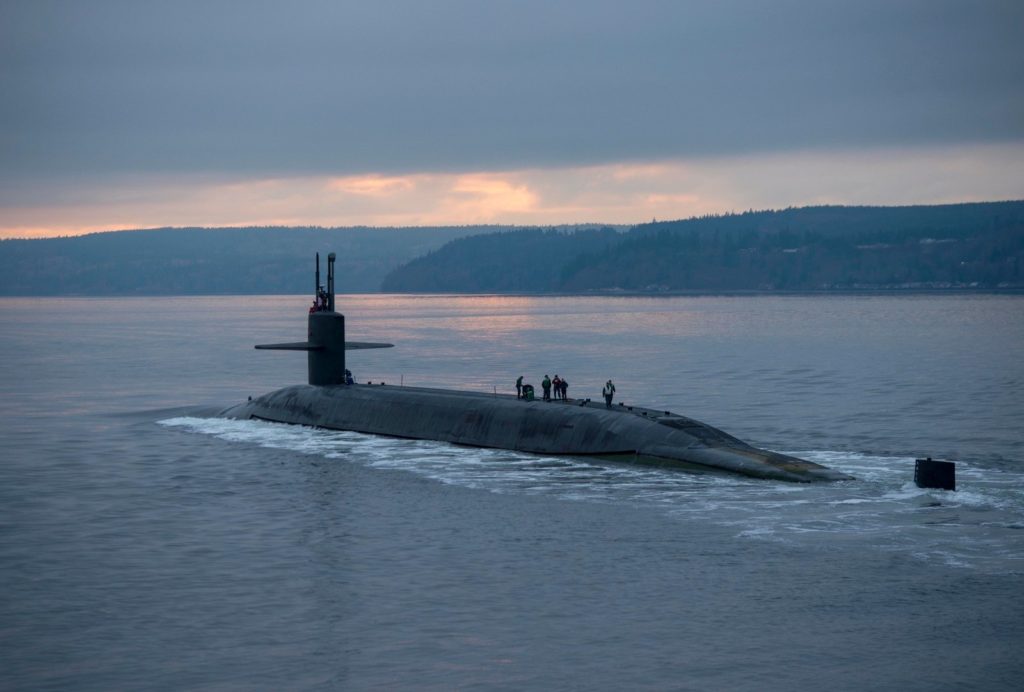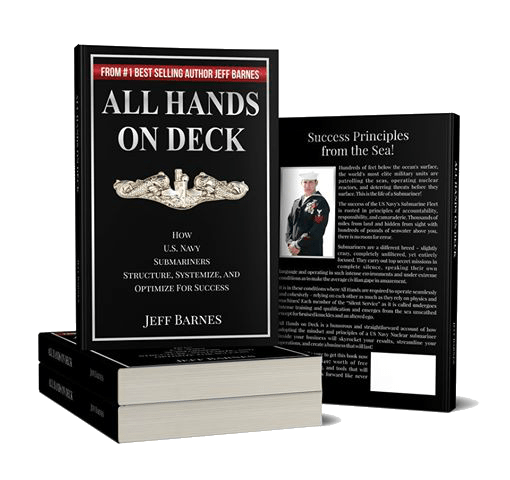What it takes to grow past $1 million, $10 million, and even $100 million successfully.
Have you ever thought about what it takes to scale a business beyond $1 million? What about past the 8 or 9 figure range?
If I simply told you the answer to that, you’d probably just say “duh. Of course.”
So instead, let me take you back in time to when I was a young buck on a submarine, and give you a real example.
You might think that running a submarine has nothing to do with running a business, but in this case, you’d be sorely mistaken. In fact, the correlations between the military and efficient business growth are so strong that I wrote an entire book on that subject, All Hands on Deck: How US Navy Submariners Structure, Systemize, and Optimize for Success.
In early 2004 I was stationed on the USS Jefferson City (SSN 759) in Bremerton, WA at the Puget Sound Naval Shipyard. At the time our nuclear power plant was shut down and we had practically the entire boat torn apart down to the foundation. New systems, piping, electrical work, and everything else was being built and added daily.
One such system was our brand-new reverse osmosis system. Exciting, right?
Well, even though reverse osmosis (RO) had been around for decades already, it had never been installed on a submarine. Prior to this, we were turning saltwater (you know, from the ocean) into potable water using our 10k gallon per day steam distilling unit.

Since submarines only have an endless supply of fresh water when they can make fresh water from the ocean, it’s pretty important that it’s done properly and without fail. Our steam distilling unit was finicky and constantly needed baby sitting and routine maintenance. In fact, on a submarine, sailors didn’t get to enjoy what we called “Hollywood showers” – a shower that would last longer than about 60 seconds of continuously running hot water – simply because our ability to make water couldn’t keep up with the demand if everyone took a nice long shower.
Instead, we would turn the water on, get wet, turn the water off, lather up, then on again and rinse. Done in about 2-3 minutes with around 1 gallon of water total being used. No one liked it, and of course some people would try to skirt the rules, but we had handy ways to stop that in its tracks. 😀
Okay, so back to the RO. We needed a more reliable, consistent system that would take the salinity from the sea out of the water so we could use the fresh water for everything from bathing, cooking, cleaning to refilling our systems and running the steam and reactor systems if needed.
So here we were, the first boat in the entire fleet with an RO unit installed. It was sleek, shiny, pretty, and made of the highest quality lightweight materials you could ask for. And it was designed to generate 12,000 gallons of fresh water per day without fail!
We were excited to say the least.
But there was a catch…it had never been tested in the open ocean!

Imagine our apprehension of being responsible for making water for the entire crew and the boat using a system that hand never been tested in the open ocean with hundreds of pounds of seawater as the source!
This is where our training, expertise, and most importantly, the key factor came in to continue proper operations indefinitely.
Once we got out to sea, we had to fire up the unit and begin operations as we’d been instructed in the docks. Unfortunately, temperatures and pressures caused the system to malfunction almost immediately.
We did what we were trained to do of course – adjust course and improvise!
A little tweak here, an adjustment here, a slower flow rate, etc. and we were in business…
Until the boat went a little deeper.
Another set of tweaks and adjustments and the water started flowing again. Voila!
But then we dove still deeper.
The machine lurched and squealed, the salinity and total dissolved solids were off, and the brine was backed up.
More adjustments needed, and now we had it humming a few hundred feet beneath the surface.
And just when we had it dialed in, up to the surface we started going. Crap!
Back to the first set of adjustments to make the machine hum again.
Okay, we had it all figured out, right?
Nope. Now we went from sub-60-degree inlet temps to seawater temperatures greater than 80 degrees and another set of adjustments were needed!
How could we ever expect a new guy to figure it all out?
Enter the Standard Operating Procedure
Standard operating procedures or (SOPs) are the lifeblood of the nuclear navy.
They dictate how, when, where, why, and what is done to keep a multi-system, multi-billion-dollar machine in operation thousands of miles from land, hundreds of feet below the surface.
If there’s one thing the Navy’s great at, it’s developing SOPs. This is how a 21-year-old mechanic can run a billion-dollar nuclear power plant without fail.
And it’s also how billion-dollar companies scale up and stay successful, and also why many companies never make it past a few employees.
Standard operating procedures should be used in every aspect of your business and will help new and veteran employees alike operate on the same page in a way that helps your company grow.
Luckily for you, we’ve designed an entire training and system that shows you how to build and deploy SOPs, as well as how to create an eight-figure business by doing so!
If you’d like a free copy of my book, along with our Definitive Guide to Creating Standard Operating Procedures, simply head over to www.AngelInvestorsNetwork.com/free-training to get started and download your books today!

